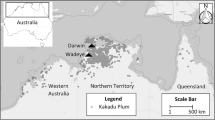Abstract
Domestication of Irvingia gabonensis, a fruit tree grown in agroforestry systems in West and Central Africa, offers considerable scope for enhancing the nutritional and economic security of subsistence farmers in the region. Assessments of phenotypic variation in ten fruit, nut and kernel traits were made on twenty-four ripe fruits from 100 Irvingia gabonensis trees in Ugwuaji village in southeast Nigeria, a center of genetic diversity for this species. There were important differences between the young planted trees of this study and the older unplanted trees of a similar study in Cameroon. Significant and continuous tree-to-tree variation was found in fruit mass(69.0–419.8 g), flesh mass (59.5–388.8 g), nut mass (9.5–40.6 g), shell mass (4.9–30.9 g) and kernel mass (0.41–7.58 g); fruit length (49.2–89.3 mm) and width (46.2–100.5 mm) and flesh depth (12.9–31.4 mm), as well as considerable variation in flesh colour, skin colour, fruit taste and fibrosity. Some fruits were considerably bigger than those found in Cameroon. These quantitative results will help in the development of cultivars within participatory approaches to agroforestry tree domestication, and so promote poverty alleviation and sustainable agriculture.
Similar content being viewed by others
References
Akubor P.I.1996. The suitability of African bush mango juice forwine production.Plant Food for Human Nutrition, 49: 213–219.
Anegbeh P.O.1990. Variation in Newbouldia laevis (P. Beauv)Seeman ex Bureau from some sources in Southwestern Nigeria. M.Sc. thesis. Department of Forest Resources Management.University of Ibadan, Nigeria. 102pp.
Atangana A.R., Tchoundjeu Z., Fondoun J.-M., Asaah E., Ndoumbe M. and Leakey R.R.B.2001. Domestication of Irvingia gabonensis: 1. Phenotypic variation in fruit and kernels in two populations from Cameroon.Agroforestry Systems, 53: 55–64.
Atangana A.R., Ukafor V., Anegbeh P.O., Asaah E., Tchoundjeu Z.,Usoro C., Fondoun J.-M., Ndoumbe M. and Leakey R.R.B.2002. Domestication of Irvingia gabonensis: 2. The selection ofmultiple traits for potential cultivars from Cameroon and Nigeria.Agroforestry Systems55: 221–229.
Ayuk E.T., Duguma B., Franzel S., Kengue J., Mollet M.Tiki-Manga T. and Zenkeng P.1999a. Uses, management andeconomic potential of Irvingia gabonensis in the humid lowlandsof Cameroon. Forest Ecology and Management113: 1–9.
Degrande A., Mbosso C., Anegbeh P.O., Ukafor V. Schreckenberg K., Kanmegne J., Tchoundjeu Z. and Kindt R. in press. On-farmdistribution of fruit trees: A case study in the humid forest zoneof Cameroon and Nigeria.Agroforestry Systems0: 000–000.
Franzel S., Jaenicke H. and Janssen W.1996. Choosing the RightTrees: Setting Priorities for Multipurpose Tree Improvement,Research Report, 8, ISNAR, The Hague, The Netherlands, 87p.
Harris D J.1996. A revision of the Irvingiaceae in Africa.Bulletindu Jardin Botanique National de Belgique 65 (1–2): 143–196
Kornerup A., and Wanscher J.H.1978. Methuen Handbook of Colour, 3rd Edition, Eyre Methuen, London. 252p.
Ladipo D.O., Fondoun J.-M. and Ganga N.1996. Domesticationof bush mango (Irvingia spp): some exploitable intraspecificvariations in West and Central Africa. In: Leakey R.R.B., Temu A.B., Melnyk M. and Vantomme P. (Eds.), Domestication andCommercialization of Non-Timber Forest Products in Agroforestry Systems: Non-Wood Forest Products No. 9, 192–205.Foodand Agriculture Organization, Rome, Italy.
Leakey R.R.B.1991. Clonal forestry: towards a strategy. Someguidelines based on experience with tropical trees. In: Jackson J.E. (Ed.), Tree Breeding and Improvement, pp. 27–42. RoyalForestry Society of England, Wales and Northern Ireland, Tring,England.
Leakey R.R.B.1999. Potential for novel food products from agroforestry trees: A review.Food Chemistry66: 1–14.
Leakey R.R.B., Atangana A.R., Kengni E., Waruhiu A.N., Usoro C., Tchoundjeu Z. and Anegbeh P.O.2002. Domestication ofDacryodes edulis in West and Central Africa: characterization ofgenetic variation.Forest, Trees and Livelihoods 12, 57–71.
Leakey R.R.B., Tchoundjeu Z., Smith R.I., Munro R.C., Fondoun J.-M., Kengue J., Anegbeh P.O., Atangana A.R., Waruhiu A.N.,Asaah E., Usoro C. and Ukafor V.In press a. Evidence that subsistence farmers have domesticated indigenous fruits (Dacryodes edulis and Irvingia gabonensis) in Cameroon and Nigeria,Agroforestry Systems.
Leakey R.R.B., Schreckenberg K. and Tchoundjeu Z. in press b.The participatory domestication of West African indigenousfruits.International Forestry Review 0, 000–000.
Lowe A.J., Gillies A.C.M., Wilson J. and Dawson I K.2000. Conservation genetics of bush mango from Central and West Africa:implications from amplified polymorphic DNA analysis.Molecular Ecology9: 831–841.
Mbosso M.F.P.C.1999. Opportunités et contraintes socio-économiques liées à la culture des arbres fruitiers locaux dansles basses terres humides du Cameroun:Dacryodes edulis etIrvingia gabonensisMémoire de fin d'études présenté pourl'obtention du diplôme d'Ingénieur Agronome, Université deDschang, 111p.
Ndjouenkeu R., Goycoolea F.M., Morris E.R. and Akingbala J.O.1996. Rheology of okra (Hibiscus esculentus) and dika nut (Irvingia gabonensis) polysaccharides.Carbohydrate polymers 29,263–269.
Ndoye O., Ruiz-Pérez M. and Eyebe A.1997. The markets ofNon-Timber Forest Products in the Humid Forest Zone of Cameroon.Rural Development Forestry Network Paper 22c, ODI,London.
Okafor J.C.1975. Varietal delimitation in Irvingia gabonensis(Irvingiaceae).Bulletin du Jardin Botanique National deBelgique 45 (1–2): 211–221.
Okafor J.C.1980. Edible indigenous woody plants in the ruraleconomy of the Nigerian forest zone.Forest Ecology and Management.3: 45–55.
Schreckenberg K., Degrande A., Mbosso C., Boli Baboule Z., Boyd C., Enyong L., Kanmagne J. and Ngong C.2002. The social andeconomic importance of Dacryodes edulis (G.Don) H.J. Lam insouthern Cameroon.Forests, Trees and Livelihoods, 12, 15–40.
Simons A.J.1996. ICRAF's strategy for domestication ofnon-wood products. In: Leakey R.R.B., Temu A.B., Melnyk M.and Vantomme P. (Eds.), Domestication and Commercializationof Non-Timber Forest Products in Agroforestry Systems: Non-Wood Forest Products No. 9, 8–22, Food and Agriculture Organization, Rome, Italy.
Tchoundjeu Z., Duguma B., Foundoun J.-M. and Kengue J.1998.Strategy for the domestication of indigenous fruit trees of WestAfrica: case of Irvingia gabonensis in southern Cameroon.Cameroon Journal of Biology and Biochemical Sciences4: 21–28.
Waruhiu A.N.1999. Characterization of fruit traits toward domestication of an indigenous fruit tree of West and Central Africa: acase study of Dacryodes edulis in Cameroon. tM.Sc. thesis University of Edinburgh. 56pp.
Author information
Authors and Affiliations
Corresponding author
Rights and permissions
About this article
Cite this article
Anegbeh, P., Usoro, C., Ukafor, V. et al. Domestication of Irvingia gabonensis: 3. Phenotypic variation of fruits andkernels in a Nigerian village. Agroforestry Systems 58, 213–218 (2003). https://doi.org/10.1023/A:1026094021408
Issue Date:
DOI: https://doi.org/10.1023/A:1026094021408




